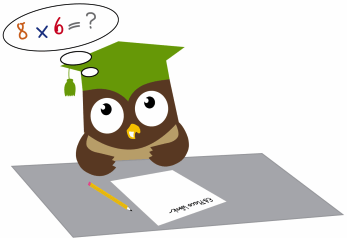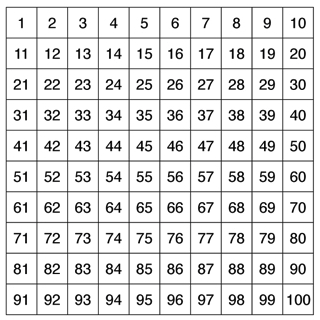So the pressure is on! Children are now expected to have memorised their times tables by the age of nine and maths assessments are moving towards more challenging, more traditional approaches of arithmetic and mathematical reasoning.
Studies have shown* that by memorising their times tables, children’s working memory is freed up to be able to tackle new mathematical learning more effectively and it enables them to deal with more complex mathematical problems more accurately. Time spent working out the time's table part can slow children down, overwhelm them and lead to eventual inaccuracies or a failure to finish. In addition, times tables are a lifelong and advantageous skill, why not invest some time over your summer to help your child crack their tables? It’s a gift that will stay with them forever.

 You don’t have to teach them in order, in fact, I would positively advise against this! Children love games, challenges, puzzles and patterns, and they love to feel confident in what they are doing so start with the easy ones, get them mastered and they will provide great building blocks to support your child to memorise the rest.
You don’t have to teach them in order, in fact, I would positively advise against this! Children love games, challenges, puzzles and patterns, and they love to feel confident in what they are doing so start with the easy ones, get them mastered and they will provide great building blocks to support your child to memorise the rest.
First of all, consider the age of your child. Key stage one children usually start with their 2’s and 10’s, followed by the 5’s. Once these are mastered you could move onto the 4’s (which are double the 2’s), then the 3’s, 6’s (which are double the 3’s) and the 11’s which have an easy pattern to follow. Once these basic tables are mastered, it makes it much easier to move onto the 8’s (double the 4’s), 12’s (double the 6’s), 9’s and 7’s.
My suggestion would be to concentrate on just one times table at a time and practise for a short time every day until it’s mastered (this could take a week or two). Too many times tables at once could overwhelm, confuse and ultimately end in failure. Better to go back to school with one or two tables fully mastered than a sense of failure and confusion.

Each times table follows a pattern and for all of us making and finding patterns can be fun! Start with physically making the times table, maybe using sweets, coins, pasta, cars, playdoh balls or anything you have to hand. The more colourful the better and if you can link the colours to patterns (doubles, odd’s and even’s) even better! Ask your child to create the times table in a row down a table or on the floor and next to each collection put a post it note.
Ask your child to write on each post-it the calculation that goes with the collection, for example; 1 x 2 = 2, 2 x 2 = 4. If possible use three different colours, one for the number of times, one for the times table and one for the answer. It’s also helpful to print out a 100 square and ask your child to find each of the answers on the square too.
[caption id="attachment_5595" align="alignright" width="320"] For a printable number chart, see the link at the bottom of the page.[/caption]
For a printable number chart, see the link at the bottom of the page.[/caption]
This can lead to lots of discussion about the patterns. Try to encourage your child to answer questions, and find their own patterns rather than giving them the answers. If they want to they can jot down their ideas to revisit the next day (or you could). Chant the times table out loud a few times, you could walk up and down the stairs chanting (one step per calculation, forwards for up, backwards for down) or as you walk down the road, you could turn this into a song or game.
Save the post-its and bring them out the next day, ask your child to order them and then chant them again. Remind them of any thoughts or ideas they had the previous day. Which calculations do they just know? Which can they work out easily? Which ones are trickier? Sort the post it’s into groups and ask your child to note down the calculations from each group. Can they put them back into order?
Start with the easy ones and cut off the part that has the answer. Can your child still chant their times tables even though you have cut off some of the answers (like 1x, 2x, 5x and 10x)?
Move onto the ones they can work out. Discuss their methods for working out? Are there any rhymes they could learn to help them? When you feel they are ready, cut off the answers for these too. Keep chanting and keep the answers visible for the more tricky ones.

At this point, it is worth utilising our worksheets for practice. We have a great selection at EdPlace. Try not to overwhelm your child, perhaps give them one or two on a specific times table each day as well as practice with chanting. Randomly ask them questions related to this times table through the day.
Once your child has had plenty of time to understand, consolidate, write out and practice, then start to test them. Randomly write the numbers 1-12 in a cloud on a piece of paper. Time them, how long does it take them to complete this? Are there any they don’t know? Go back and practise just these.
The next day test them again, are they faster? More accurate? If so test them each day but at this stage you could move onto the next times table on your list and start the process again.
Don’t let go of the great work they have done though, at this stage it needs to be repeated enough to move from short-term to long-term memory. Each day give them one worksheet or one test or chant it through, just to remind them of how good they are with this times table and don’t forget to praise them… and you for doing such a good job!
 _
_
If you are an existing customer, simply Log in and assign the worksheets to your child for them to complete.
-
Written by Mrs Latham. our maths teacher. Mrs Latham's summer top tip is:
"Learning is important, but having is fun while learning is more important!"
*Improving Basic Multiplication Fact Recall for Primary School Students - Monica Wong and David Evans, University of Sydney 2007
**http://www.teachingideas.co.uk/place-value/number-square-templates











